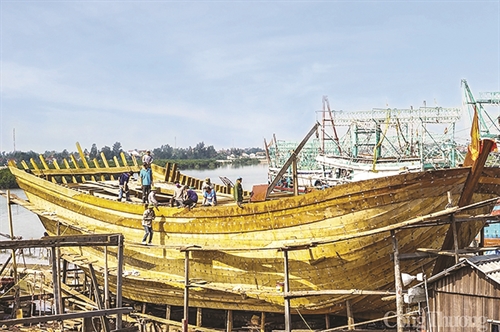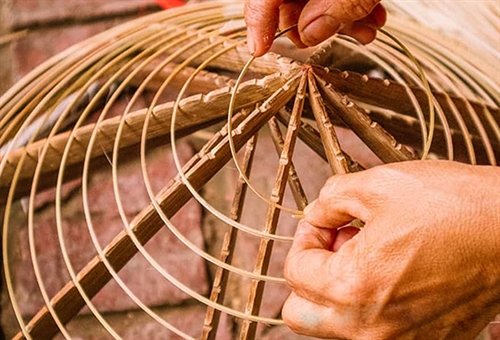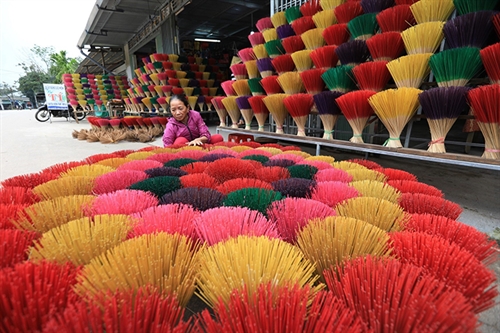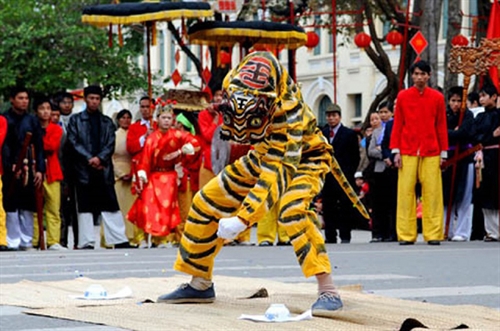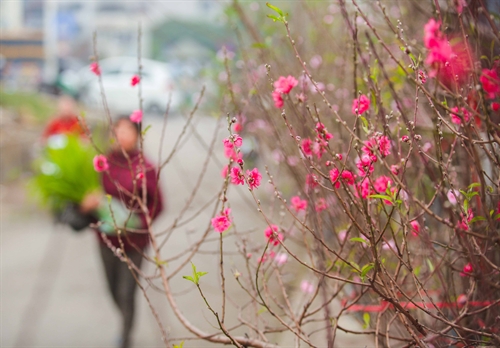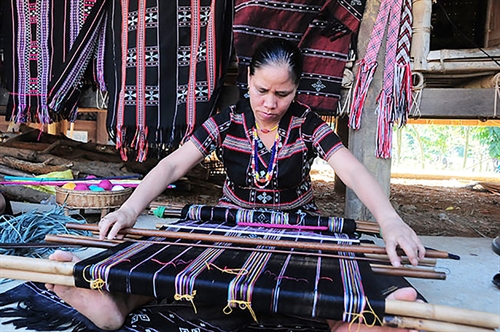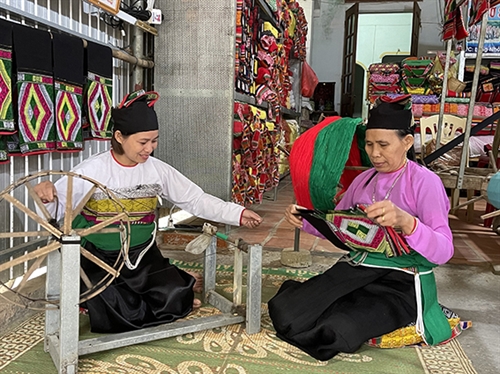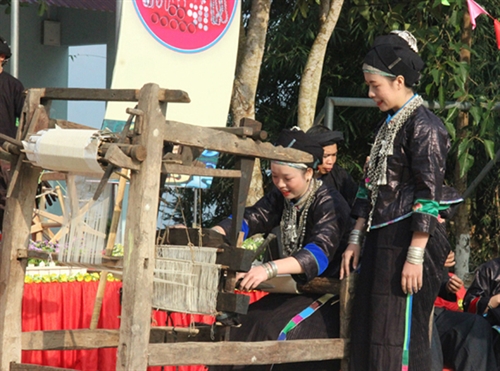Editor Do Thi Nguyet Que
Located in Phu Nghia commune, Chuong My district, 27 kilometers to the southwest of Hanoi, the Phu Vinh bamboo and rattan weaving craft village is dubbed “the land of rattan” for its well-known handcraft decorative and utility products.
No one knows exactly when the village’s first bamboo and rattan products were made but its rattan and bamboo weaving craft is thought to date back about 400 years ago. In the village, then called Phu Hoa Trang, there existed a large hill which was home to a big flock of white storks. In order to take advantage of beautiful stork feathers, villagers used them to weave hats. At first, they gave these hats as gifts for friends and relatives and then sold to people living nearby. When the demand grew and stork feather supplies run out, villagers shifted to use soft and flexible materials like grasses, bamboo and rattan strings to make household utensils such as plates, trays, sieves, baskets and boxes, among others.
The weaving techniques were handed down from generation to generation and Phu Hoa Trang villagers’ workmanship became better and better. In 1800, the village name was changed to Phu Vinh. Under the reign of King Thanh Thai (1889-1907), the 10th king of the Nguyen dynasty, nine senior bamboo and rattan weaving artisans of Phu Vinh village were rewarded honorary titles by the King. Nowadays, when it comes to bamboo and rattan weaving, there is no one who does not know about the great name of artisan Nguyen Van Khieu (1905-1983) of Phu Vinh village, who succeeded in weaving a portrait of late President Ho Chi Minh from rattan strings. “Bamboo and rattan weaving is truly difficult and you are considered successful only when you can make soulful products,” Khieu once said.
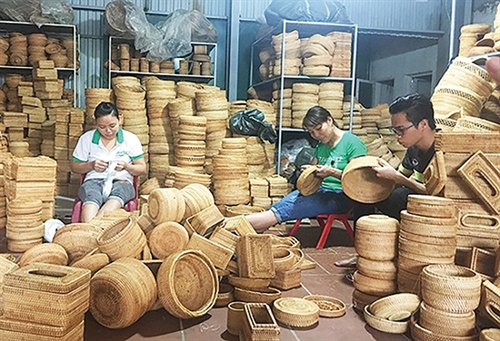 |
| Producing bamboo and rattan products in Phu Vinh craft village__Photo: https://langngheviet.com.vn/ |
Phu Vinh village is famous for its beautiful bamboo and rattan items with different designs and shapes. The products range from household items to ornaments including necklaces, bracelets and earrings; furniture such as sofas, shelves, stools, lampshades, photo frames, flower vases and window blinds; and decorative objects which require manual dexterity like calligraphy, portraits and animal statues.
It is not easy to create beautiful handicraft items from bamboo strips or rattan hanks, but it is much more difficult to use them to weave a portrait in a way that can display the style and posture of the model. Painters may use seven primary colors for a painting while rattan weavers have only black and white for their works of art.
“The unique feature of Phu Vinh village’s products lays not only in the skills and techniques but also special, sophisticated and meticulous braiding lines. There are some flower braiding patterns that can only be made by Phu Vinh villagers,” said Nguyen Van Tinh - the son of late artisan Nguyen Van Khieu.
The making of bamboo and rattan objects, regardless of whether they are relatively simple or sophisticated, must go through the same steps of collecting, processing and preparing materials to the final stage of weaving.
The preparatory process of bamboo material is a little bit different from that of rattan one.
For bamboo, experienced craftsmen know how to classify old and young bamboo trees. They vary in thickness, flexibility and length. Old bamboo trees can be used to make edges and frames while young ones can be used for splints. After harvested, weavers put carefully chosen pieces of bamboo out to dry. They then soak bamboo culms in a special solution for about 10 days to prevent termites. Past the mentioned time, crafters take them out of the tank, chop off any bumps, scrap off the outermost green layer of the bamboo, smooth the bamboo surface by applying sandpapers to burn all marks and scratches and dry them out thoroughly. To create light brown or dark brown bamboo items, they need to toast completely dried bamboo stalks by straws or bamboo leaves in a closed furnace. After being straightened, these bamboo culms are cut into bars with a width of between two centimeters and five centimeters or split into thinner strips which are ideal for making bamboo products. The thickness and size of the strips depend on the requirements of the products. Nowadays, Phu Vinh weavers sometimes bamboo culms and their products with one layer of paint not only to color them but also to make sure they can withstand humidity and free of molds and insects. Machines are also used to split and smooth small tubes or strips.
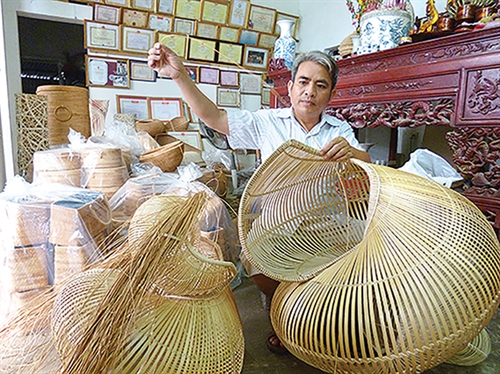 |
| Artisan Nguyen Van Tinh of Phu Vinh craft village__Photo: https://phapluatxahoi.kinhtedothi.vn/ |
To make rattan ware, it is ideal to collect rattan trees when they are about three meters high. In the rattan preparatory process, splitting, toasting and drying rattan canes are considered important steps. To begin the process, crafters have to straighten rattan canes. As the internodes of rattan vary in length and thickness in different plants of the same species, they use sharp knives to peel off the outer thorny skin of the stems and remove the knots and cut them into three-meter pieces. These pieces are later split into thin spokes or hanks. Thick hanks are used to weave products’ rims while thin ones are used to create flowers on rattan products. In reality, a small rattan cane is often split into four or six hanks while a bigger one is split into seven or nine hanks. After that, craftsmen use point knives to whittle and polish these hanks and put them out to dry. Rattan will lose its shiny ivory color if it gets wet and lose its freshness if it is over dried. After dried, rattan hanks are toasted in a closed furnace. Their color will change if there are too much or less smoke. Phu Vinh villagers have a special way to color their products. They boil water with leaves of Chinese tallow tree (Triadica sebifera) and dip rattan hanks into the solution to create a color layer for their products which is unfadeable for up to 40 years.
When the aforementioned steps are done, the bamboo strips and rattan hanks are ready for weaving. There are different techniques that may be used to make a piece of work. To make a piece of furniture, assembly technique is used to combine different parts of a furniture for forming a product while weaving technique is applied based on the frame.
Weaving techniques such as rolling skills, flower and interlacing flower braiding techniques can be used for making both bamboo and rattan products. The results vary in thickness and stiffness. To create classic and ordinary weaving patterns, artisans may also use under-and-over weaving, double weaving, pairing weaving and triple twist weaving techniques. The purpose and the form of products will decide the techniques to be used by weavers.
To finish the last step of the process, weavers polish their hand-woven products and may color them according to their customers’ requests.
With hundreds of households engaged in bamboo and rattan weaving, Phu Vinh has become an ideal destination for those who want to explore craft villages and keen on bamboo and rattan products.-
